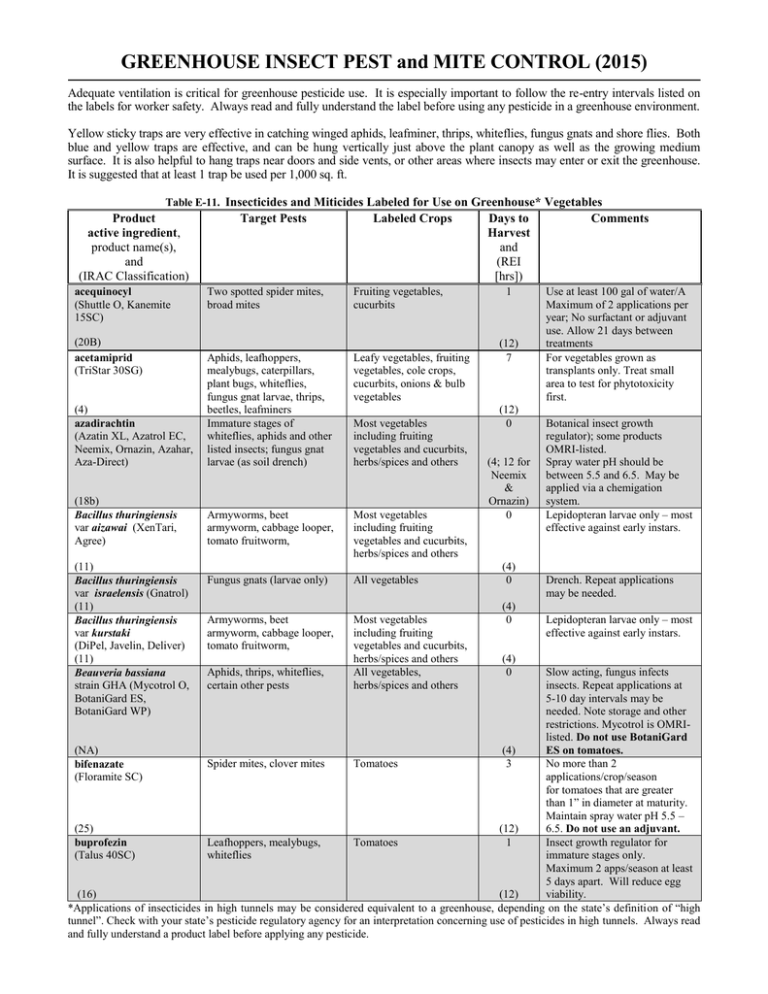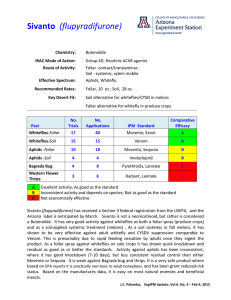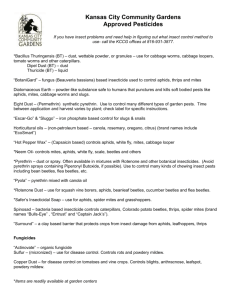GREENHOUSE INSECT PEST and MITE CONTROL (2015)
advertisement

GREENHOUSE INSECT PEST and MITE CONTROL (2015) Adequate ventilation is critical for greenhouse pesticide use. It is especially important to follow the re-entry intervals listed on the labels for worker safety. Always read and fully understand the label before using any pesticide in a greenhouse environment. Yellow sticky traps are very effective in catching winged aphids, leafminer, thrips, whiteflies, fungus gnats and shore flies. Both blue and yellow traps are effective, and can be hung vertically just above the plant canopy as well as the growing medium surface. It is also helpful to hang traps near doors and side vents, or other areas where insects may enter or exit the greenhouse. It is suggested that at least 1 trap be used per 1,000 sq. ft. Table E-11. Insecticides and Miticides Labeled for Use on Greenhouse* Vegetables Product active ingredient, product name(s), and (IRAC Classification) Target Pests Labeled Crops Two spotted spider mites, broad mites Fruiting vegetables, cucurbits Leafy vegetables, fruiting vegetables, cole crops, cucurbits, onions & bulb vegetables (4) azadirachtin (Azatin XL, Azatrol EC, Neemix, Ornazin, Azahar, Aza-Direct) Aphids, leafhoppers, mealybugs, caterpillars, plant bugs, whiteflies, fungus gnat larvae, thrips, beetles, leafminers Immature stages of whiteflies, aphids and other listed insects; fungus gnat larvae (as soil drench) (18b) Bacillus thuringiensis var aizawai (XenTari, Agree) Armyworms, beet armyworm, cabbage looper, tomato fruitworm, Most vegetables including fruiting vegetables and cucurbits, herbs/spices and others Fungus gnats (larvae only) All vegetables Armyworms, beet armyworm, cabbage looper, tomato fruitworm, Most vegetables including fruiting vegetables and cucurbits, herbs/spices and others All vegetables, herbs/spices and others acequinocyl (Shuttle O, Kanemite 15SC) (20B) acetamiprid (TriStar 30SG) (11) Bacillus thuringiensis var israelensis (Gnatrol) (11) Bacillus thuringiensis var kurstaki (DiPel, Javelin, Deliver) (11) Beauveria bassiana strain GHA (Mycotrol O, BotaniGard ES, BotaniGard WP) Aphids, thrips, whiteflies, certain other pests Most vegetables including fruiting vegetables and cucurbits, herbs/spices and others Days to Harvest and (REI [hrs]) Comments 1 Use at least 100 gal of water/A Maximum of 2 applications per year; No surfactant or adjuvant use. Allow 21 days between treatments For vegetables grown as transplants only. Treat small area to test for phytotoxicity first. (12) 7 (12) 0 (4; 12 for Neemix & Ornazin) 0 (4) 0 (4) 0 (4) 0 Botanical insect growth regulator); some products OMRI-listed. Spray water pH should be between 5.5 and 6.5. May be applied via a chemigation system. Lepidopteran larvae only – most effective against early instars. Drench. Repeat applications may be needed. Lepidopteran larvae only – most effective against early instars. Slow acting, fungus infects insects. Repeat applications at 5-10 day intervals may be needed. Note storage and other restrictions. Mycotrol is OMRIlisted. Do not use BotaniGard (NA) (4) ES on tomatoes. Spider mites, clover mites Tomatoes 3 No more than 2 bifenazate (Floramite SC) applications/crop/season for tomatoes that are greater than 1” in diameter at maturity. Maintain spray water pH 5.5 – (25) (12) 6.5. Do not use an adjuvant. Leafhoppers, mealybugs, Tomatoes 1 Insect growth regulator for buprofezin (Talus 40SC) whiteflies immature stages only. Maximum 2 apps/season at least 5 days apart. Will reduce egg (16) (12) viability. *Applications of insecticides in high tunnels may be considered equivalent to a greenhouse, depending on the state’s definition of “high tunnel”. Check with your state’s pesticide regulatory agency for an interpretation concerning use of pesticides in high tunnels. Always read and fully understand a product label before applying any pesticide. Table E-11. Insecticides and Miticides Labeled for Use on Greenhouse* Vegetables Product active ingredient, product name(s), and (IRAC Classification) chlorfenapyr (Pylon) (13) cyantraniliprole (Exirel) (28) cyromazine (Citation) (17) dinotefuran (Safari 20 SG) (4) etoxazole (TetraSan 5WDG) (10B) fenpyroximate (Akari) (21A) flonicamid (Beleaf 50 SG) (9C) hexythiazox (Onager miticide 1EC) (10A) iron phosphate (Sluggo-AG) (Escar-Go) imidacloprid (Marathon) (4) imidacloprid (Admire PRO) Target Pests Caterpillars, spider mites (Tetranychus spp.), broad mites, western flower and melon thrips. Thrips, Whitefly Tomato, tomatillo, ground cherry, peppers, eggplant, pepinos leafminers, fungus gnats, shore flies Only for vegetable transplant production grown for consumers Cucurbits, fruiting vegetables, head and stem brassicas, leafy vegetables Aphids, leafminers, mealybugs, whiteflies Tomato, eggplant, peppers Days to Harvest and (REI [hrs]) Comments 0 Do not use on tomato varieties with mature fruit less than 1 inch in diameter. No more than 3 applications per crop. For whitefly add effective adjuvant. Only suppresses thrips (12) 1 (12) 7 (12) 1 (all but leafy) 7 (leafy) Spider Mites Tomatoes only (12) 1 Two spotted spider mites (suppresses whiteflies) Cucumbers (12) 7 aphids, plant bugs, GH whitefly Cucumbers (12) 0 Twospotted spider mites, European red mites Tomatoes (12) 1 Slugs and snails All vegetables (12) 0 Aphids, fungus gnat larvae, leafhoppers, whiteflies, others Cole crops, collards, kale, kohlrabi, lettuce, mustard greens, pepper, tomato, eggplant. Tomato and cucumber only in production greenhouses. Aphids, whiteflies (4) malathion (Gowan Malathion 8F) Labeled Crops (0) - (12) 0 (12) Japanese beetles, thrips, onion maggots Do not apply within 7 days of shipping to market. No more than 6 applications per crop. One application/crop. For vegetable transplants only. May be applied via a chemigation system. Do not make more than 2 applications per season. Do not use with an adjuvant. One application per growing season. Do not use adjuvants. Allow a minimum of 7 days between applications. Whitefly suppression only Do not make more than 1 application per year OMRI-listed. Bait; scatter around plants or perimeter of plantings. Use on vegetable plants intended for resale only. May be applied via a chemigation system. Do not apply to plants growing hydroponically or in rock wool, perlite or other soil-less mix; only for plants growing in field soil, potting media or mixes. May be applied as drench or chemigation system. Label notes possible repellent effect on bumblebees and some beneficials (Orius sp.) See label for specific crops. May be applied through a chemigation system. Succulent beans, 1-7 cucumbers, eggplant, lettuce, green and bulb onions, sweet corn, (1) tomatoes (crops vary depending on mfg. label) (12) *Applications of insecticides in high tunnels may be considered equivalent to a greenhouse, depending on the state’s definition of “high tunnel”. Check with your state’s pesticide regulatory agency for an interpretation concerning use of pesticides in high tunnels. Always read and fully understand a product label before applying any pesticide. NA: Not Applicable. Table E-11. Insecticides and Miticides Labeled for Use on Greenhouse* Vegetables Product active ingredient, product name(s), and (IRAC Classification) paraffinic oils (Sunspray Ultra-fine SuffOil-X) (N/A) potassium salts of fatty acids (insecticidal soap) (M-Pede) (N/A) pyrethrins (Pyrenone Crop Spray, Pyronyl Crop Spray, PyGanic, Pyrethrum PT) (3a) pyriproxyfen (Distance) (7c) rosemary oil + peppermint oil (Ecotec) spirotetramat (Kontos) (23) thiamethoxam (Flagship 25WG) Target Pests Labeled Crops Days to Harvest and (REI [hrs]) Comments Aphids, two spotted spider mites, leafminers, thrips, whitefly Many, tomato, pepper, lettuce, cucurbits, radish, squash, herbs, spices 1 Do not exceed 4 applications a growing season. Allow 2 weeks between applications. Aphids; leafminer; spider, broad and russet mites; thrips; whiteflies; plant bugs; leafhopper; powdery mildew (cucumber only) All Many vegetables (see label for specifics), herbs/spices Whiteflies, aphids, fungus gnats, shoreflies Fruiting vegetables (except non-bell peppers) Aphids, beetles, mites, thrips, plant bugs, others Many vegetables, herbs/spices Aphids, leafhoppers, mealybugs, psyllids, spider mites, spittlebugs, whiteflies Vegetable transplants only (see label for list) Whiteflies, leafhoppers, Colorado potato beetle, stinkbugs Fruiting vegetables and cucurbits All vegetables, herbs/spices (4) 0 (12) 0 (12) 1 (12) 0 (0) - (24) - Works well on whiteflies, mites and aphids if coverage is good but has no residual control. Note label cautions about application frequency, water quality and tank mixing. OMRI-listed Pyrenone and Pyronyl include PBO synergist; PyGanic is OMRI-listed. Insect growth regulator. Do not use on tomato varieties with mature fruit less than 1 inch in diameter. OMRI-listed. Can be applied in drip for soil pests. Apply as drench or via an irrigation system to plants in containers. Not for use in vegetable production. ONLY use for vegetable transplants intended for resale (4a) (12) *Applications of insecticides in high tunnels may be considered equivalent to a greenhouse, depending on the state’s definition of “high tunnel”. Check with your state’s pesticide regulatory agency for an interpretation concerning use of pesticides in high tunnels. Always read and fully understand a product label before applying any pesticide. NA: Not Applicable




